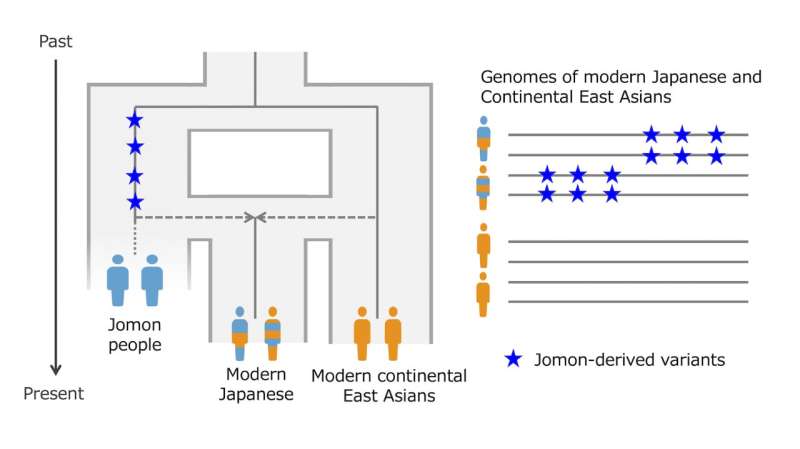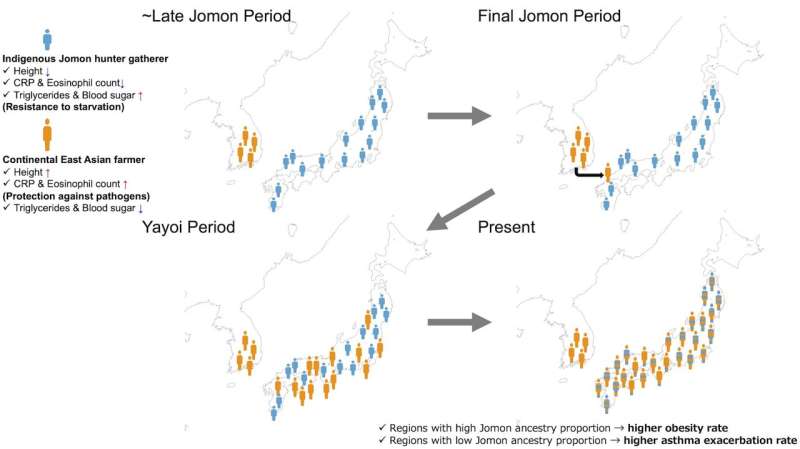
Ask someone from Japan about the Japanese, and they may tell you they have a very homogeneous society. But of course it’s understood that everywhere is made up of a mix of people, whether that diversity occurred historically or more recently.
Modern Japanese are mainly thought to descend from a mix of two populations: the Jomon hunter-gatherers (who arrived around 14,000 B.C.) and continental East Asian farmers (who started to migrate around 800 B.C.). Although archaeological evidence has provided some insight into these two communities and their history, the details of their regional spread and intermixing was not fully understood.
“I wanted to uncover the origins of the people of the Japanese archipelago in order to explore my own roots. So I co-developed a statistical method to specifically detect genetic variants from Jomon ancestry, as compared to variants arising from continental East Asians or other novel variants. We have called it the ancestry-marker index (AMI),” explained Project Assistant Professor Yusuke Watanabe from the Graduate School of Science.
“In anthropology, summary statistics are commonly used to detect genetic components arising from the mixing (called admixture) of previously isolated populations. The most widely used is called ‘S*’, which is useful for identifying archaic hominin-derived ancestry, i.e., Neanderthals and Denisovans, whose divergence time from modern humans dates back hundreds of thousands of years ago.
“But this tool didn’t work for Japan’s population history. In comparison, our AMI statistic can detect ancestry-derived genetic variants from the admixture of two more recently diverged populations (occurring only thousands of years ago), like we have in Japan.”

Using AMI and a genetic marker of Jomon ancestry called the Jomon allele score (JAS), the team studied the genetic data of 10,842 people from across Japan. Their genetic scores indicated the proportion of Jomon ancestry, and when compared to population size indicators from archaeology, the researchers found a correlation.
Previous studies had shown that rice farming first started in the northern part of Kyushu, the southernmost of the country’s main islands, and then spread to the Kinki region in west central Japan (which includes modern day Osaka and Kyoto) and the main island of Shikoku in the southwest. The scores for those regions were relatively low, indicating a lower Jomon and higher immigrant population.
By comparison, scores were highest for the southern island of Okinawa, followed by the Tohoku region in the northeast and the Kanto area in central Japan (containing Tokyo), where people are considered by anthropologists to possess more Jomon ancestry.
Furthermore, while studying Jomon-derived genetic variants in modern Japanese, the team also found some important differences. While Jomon hunter-gatherers had traits which made them more resistant to starvation (due to higher blood sugar and triglyceride fat levels), the continental East Asian farmers were generally better protected against disease (thanks to higher C-reactive protein [CRP] and eosinophil white blood cell counts, which are involved in immune response).
The researchers then looked at the regional differences in obesity rates among 5-year-old children and incidences of asthma. People from regions with a higher proportion of Jomon ancestry appeared to have a genetic predisposition towards obesity, while those from regions with higher continental East Asian ancestry have more exacerbated asthma (as the same eosinophils that protect against disease can contribute to inflammatory responses).
“We discovered that the proportion of Jomon ancestry is significantly related to modern regional differences in obesity and asthma among Japanese individuals,” said Watanabe. “Given that variations in Jomon ancestry appear to play a role in regional variations of disease in Japan, it’s possible that in the future, personalized medicine may need to take these ancestral regional differences into account.
“Now I am exploring potential uses for the data on Jomon-derived genetic variants to new research, which might help us better understand the physiological characteristics of our ancestors,” explained Watanabe. “However, AMI is not only applicable to the Japanese, but also to other admixed human populations such as Remote Oceanian (indigenous to islands in the Pacific Ocean region east of New Guinea and the Solomon Islands), Malagasy (of the island country of Madagascar in the Indian Ocean, off the southeastern coast of Africa) and more. So, I hope AMI will be used by others to further research into diversity and their own roots.”
More information:
Yusuke Watanabe et al, Modern Japanese ancestry-derived variants reveal the formation process of the current Japanese regional gradations, iScience (2023). DOI: 10.1016/j.isci.2023.106130
Journal information:
iScience
Source: Read Full Article